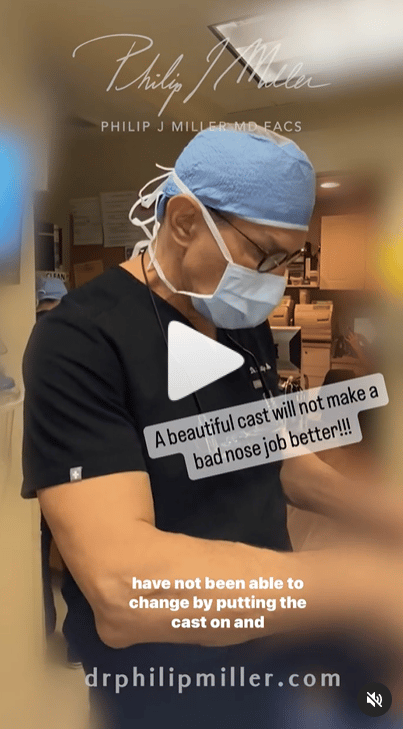Why do you have to wear a cast after rhinoplasty?
There are many types of rhinoplasty procedures, and some require a nose cast, or nasal splint, after the procedure to protect, compress, and position the nose. Nose casts can be created with a series of nasal tape applications and adhesive foam applied outside the nose during the initial healing process. The type of cast and suggested timeframe to wear the nose cast after surgery depend on your personalized treatment recovery plans.
Why Dr. Miller Uses a Cast After Rhinoplasty
Dr. Miller strives to provide patients with a positive rhinoplasty experience. To ensure optimal healing, he uses nasal casts to aid in post-operative recovery. A nose cast after rhinoplasty is a protective tool that ensures an effective recovery. The cast can be used to:
- Protect the nose from injury while it is healing
- Compress the nose to reduce swelling and minimize side effects such as drainage or bleeding
- Position the nose correctly so it remains in place during healing
There are many factors that can be addressed during a rhinoplasty procedure that can produce different side effects and recovery time. For example, restructuring bones may require additional healing and a different type of nose cast than a rhinoplasty that focuses on a bulbous tip or nostril reshaping. Dr. Miller takes time with each patient to review appropriate aftercare instructions and recovery expectations.
How is the cast applied?
After the rhinoplasty procedure, the nose cast is applied outside the nose to provide support and help reduce side effects such as swelling. Depending on your surgical procedure, the cast may vary. Surgical-grade tape is cut to length and secured with adhesive foam. Several layers of this process create a stiff cast-like covering to protect the nose and keep it in place. Gentle pressure is applied to the nose cast to ensure it forms in the correct shape and provides compression. The splint is durable and should not move or become loose before the appropriate time to remove it.
When is it safe to remove the cast after rhinoplasty?
A typical surgical rhinoplasty procedure requires a nose cast for six to seven days. Patients with a liquid rhinoplasty do not require a nose cast, and patients who received a micro rhinoplasty procedure only require a nasal splint for three days.
The nose cast is meant to allow the nose to set into its new shape and begin healing without harm or injury. The post-operative protective tool significantly impacts the long-term results and recovery after surgery.
Philip J. Miller, MD, FACS, is a world-renowned facial plastic surgeon with more than two decades of experience. He specializes in cosmetic facial procedures and is a leading expert in rhinoplasty and facial rejuvenation. Dr. Miller strives to create natural results with the NatraLook® process. This enriching experience helps patients explore their aesthetic beauty goals in a safe and supportive environment. NatraLook allows patients to partner with Dr. Miller and design a unified vision for natural and unmatched surgical results.
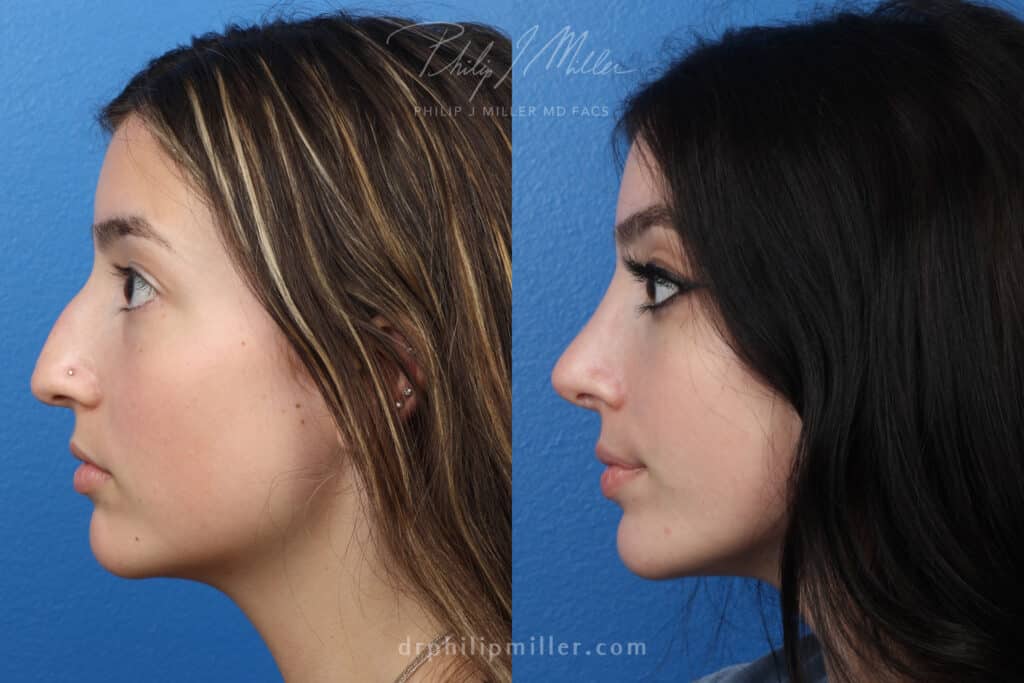
As part of his expertise and distinguished research and training, Dr. Miller uses nose casts to set patients up for success after a surgical rhinoplasty. From pre-operative consultations to post-operative care and questions, he provides patients with unsurpassed care.
Contact us to schedule a consultation and learn more about nose casts after rhinoplasty.
Surgical or Liquid (Non-Surgical) Rhinoplasty: Which one is right for me?
When it comes to getting a nose job, there are two basic options: surgical or non-surgical. Surgical rhinoplasty requires anesthesia, incisions, and downtime, but produces permanent improvement. A non-surgical rhinoplasty, commonly known as a liquid rhinoplasty, is a less invasive option that utilizes injectable fillers to temporarily change the appearance of the nose.
When considering a rhinoplasty, it is essential to realize that different types of rhinoplasty procedures are used, depending on the severity of alterations. Individualizing a rhinoplasty procedure ensures that results are natural and balanced to your unique facial features.
What is liquid rhinoplasty?
Liquid rhinoplasty is a non-surgical alternative to a surgical rhinoplasty procedure that uses injectable dermal fillers to make the nose more appealing. This less invasive option may produce pleasing results with a quicker approach and less recovery time.
Juvederm® and Restylane® are two common dermal fillers used for liquid rhinoplasty. Juvederm is an FDA-approved volume enhancer containing hyaluronic acid, a naturally occurring substance in the body. Restylane is another hyaluronic acid injectable that restores and rejuvenates the skin. These fillers can add hydration and volume to the nose and alter the shape for a more appealing appearance.
Even though liquid rhinoplasty is not a surgical procedure, it still requires skill and experience to inject the filler into the correct area for intended results. The process is quick and patients can return to normal daily activities after the injection. It is an effective alternative with many benefits, including:
- Non-invasive
- Minimal downtime
- Safe and effective
- Instant results
- Smoother nose shape
- More balanced appearance
What’s the difference between liquid and regular rhinoplasty?
Surgical and liquid rhinoplasty are two very different procedures with different processes, results, recovery, costs, and expectations. Take a look at the breakdown:
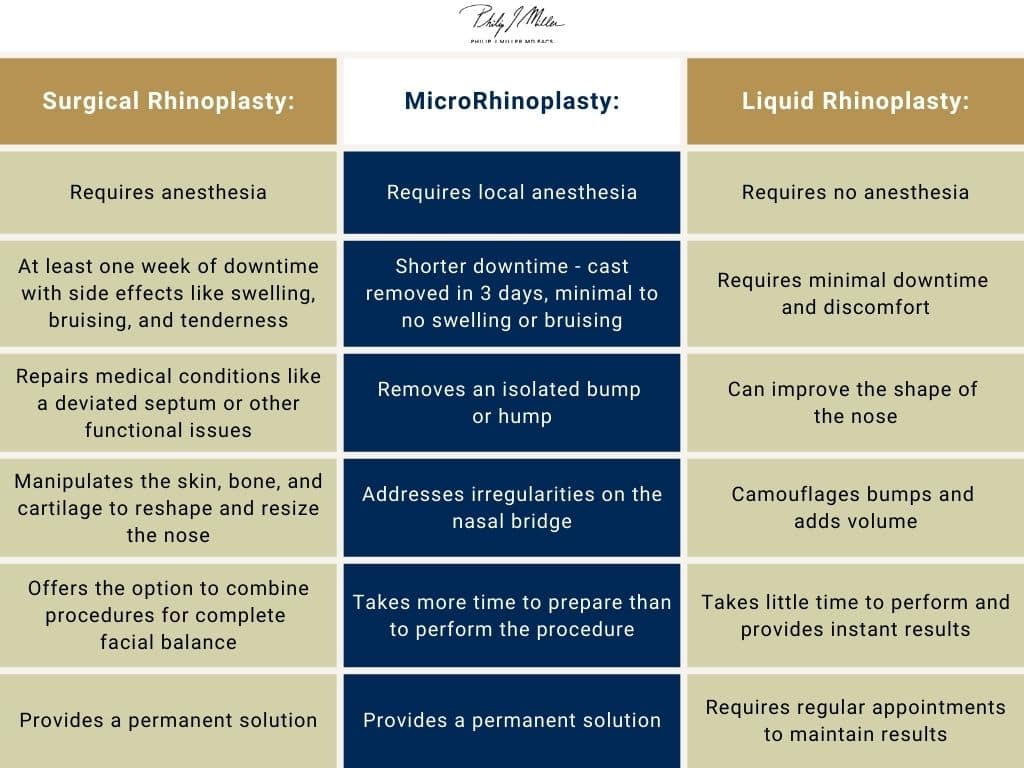
Surgical Rhinoplasty:
- Requires anesthesia
- Manipulates the skin, bone, and cartilage to reshape and resize the nose
- Repairs medical conditions like a deviated septum or other functional issues
- Requires downtime of at least one week before returning to work and daily activities
- Is associated with side effects like swelling, bruising, and tenderness
- Provides a permanent solution
- Offers the option to combine procedures for complete facial balance
Liquid Rhinoplasty:
- Is minimally invasive
- Requires minimal downtime and discomfort
- Can improve the shape of the nose
- Camouflages bumps and adds volume
- Takes little time to perform
- Provides instant results
- Is associated with minimal swelling, bruising, and tenderness
- Requires regular appointments to maintain results
How much does liquid rhinoplasty cost in NYC?
The cost of rhinoplasty procedures varies by patient and depends on the treatment plan. Non-surgical rhinoplasty costs typically range from $300-$1300 per treatment. Some of the factors that impact price include:
- Type of dermal fillers used
- Number and amount of filler injected
- Experience and expertise of injector
It is also important to understand that liquid rhinoplasty is not a permanent solution and requires regular appointments to maintain the desired shape. Patients can learn more about the specific costs of liquid rhinoplasty during a consultation with Dr. Miller.
@drphilipjmiller #liquidrhinoplasty ! In 10 minutes, no down time, you will have a new nose that last about 2 years. Call today and book a session with me! #nonsurgicalrhinoplasty ♬ original sound – Sam Smith
How much does surgical rhinoplasty cost in NYC?
Surgical rhinoplasty encompasses a wide range of possible alterations and additional steps, such as a graft or implant. Due to the variance in procedure possibilities, there is also a wide range of costs. An average surgical rhinoplasty procedure in New York City ranges from $3,500-$25,000. During a consultation, Dr. Miller will explain the treatment plan and expected costs.
How long does liquid rhinoplasty last?
Unlike a surgical rhinoplasty, liquid rhinoplasty is not a permanent solution. This treatment requires regular appointments to maintain your pleasing results. Results vary by patient depending on how many dermal fillers were used, where they were injected, and the level of correction required. Many patients see results for around 18 months before needing a touch-up session. Dr. Miller and his expert team will evaluate your nose and treatment plan for a suggested maintenance schedule to keep a natural and well-balanced nose shape.
How long does surgical rhinoplasty last?
Surgical rhinoplasty is a permanent procedure that has lifelong results. Once the nose is reshaped and altered, it will remain in its new state with proper care.
Which one is better: surgical or non-surgical rhinoplasty?
Both procedures are practical and effective solutions, depending on the patient’s specific needs and desires. Philip Miller, MD, FACS, strives to help patients achieve aesthetic confidence and natural results using the NatraLook® process. During your consultation, Dr. Miller discusses your concerns and expectations to identify which procedure is right for you and create a unified treatment plan.
Dr. Miller is a double board-certified surgeon in facial plastic and reconstructive surgery and head and neck surgery. He is a world-class surgeon and leading expert in rhinoplasty and facial rejuvenation. With more than 20 years of expertise, Dr. Miller works closely with patients to identify their needs and desires to create unmatched results.
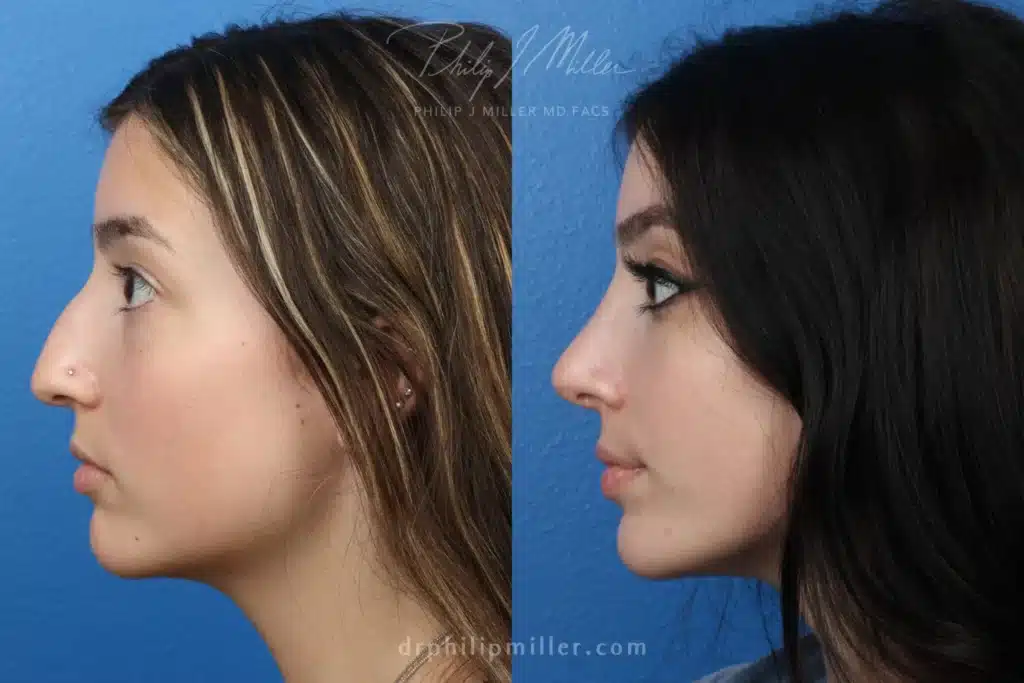
Contact us to schedule a consultation and learn more about which rhinoplasty procedure is right for you.
Nose Taping After Rhinoplasty
Nose taping is a common practice among rhinoplasty patients. It is a bandage or tape used during rhinoplasty recovery to support the nose, decrease swelling, and improve the nose’s appearance. Philip Miller, MD, FACS, often recommends nose taping to enhance a patient’s healing process after nose surgery, provided it’s done correctly.
What are the benefits of nose taping after rhinoplasty?
Nose taping after rhinoplasty is beneficial for many reasons. The primary benefit is that it helps to decrease swelling fluctuations after the procedure. It also helps improve:
- Bruising
- Bleeding
- Breathing
- Healing process
- Final appearance
Some patients choose to tape their noses daily or multiple times per day to help them feel better. However, it is most commonly recommended at night when swelling is most likely to occur. It is not necessary to tape during the day unless specified by Dr. Miller.
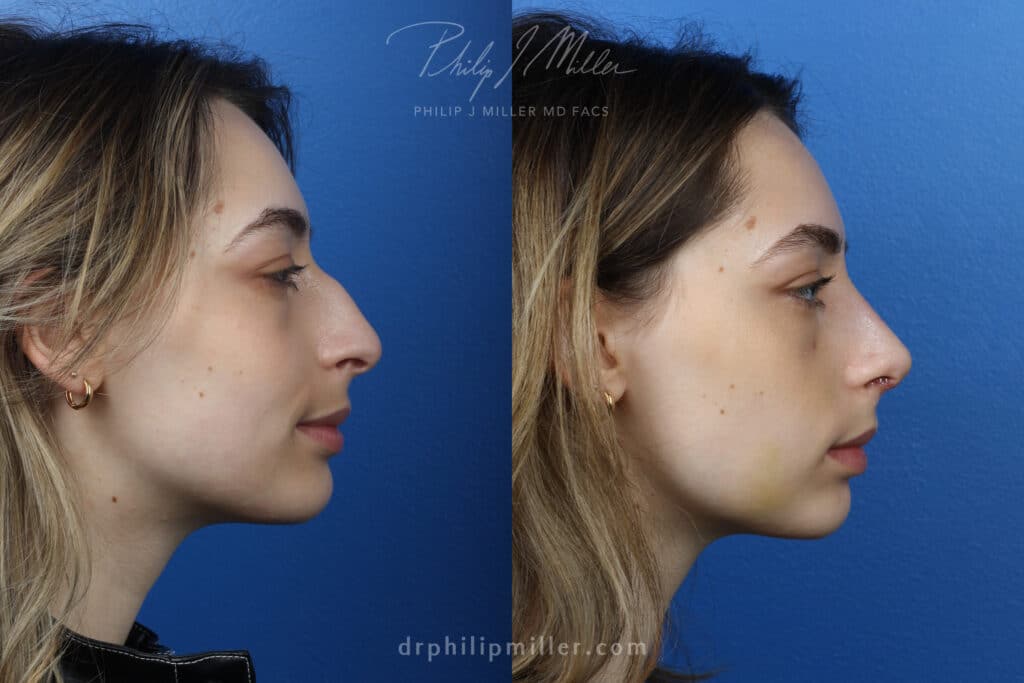
What if I don’t tape my nose after rhinoplasty?
Not all patients have to tape their nose after rhinoplasty surgery; it should only be done following instructions from a skilled board-certified facial plastic surgeon. Dr. Miller works closely with each patient to determine the benefit and necessity of nose taping. There are cosmetic and health benefits associated with taping. If the nose taping process is not followed as directed, it could lead to:
- Nose deformity
- Extended healing time
- Additional complications
- Increased swelling
How to Tape Your Nose after Rhinoplasty
There are multiple kinds of tape to use after rhinoplasty. Common choices are adhesives, like medical tape and bandages, and those that use pressure, like dental bandages. Speak to your surgeon about taping instructions best suited for your situation and healing expectations. Generally, patients should:
1. Tape the nasal bridge: Use 3-5 strips of tape about two inches long. Start at the tip of your nose and overlap upward to cover the entire bridge.
2. Wrap the tip: Use a longer piece of tape to wrap the end of the nose, creating a “U” shape while avoiding the nostrils.
3. Repeat the first step: Repeat the first step using strips to cover the bridge and ensure the “U” tape stays in place.
At first, nose taping may be necessary 24/7, depending on your specific circumstances. In this case, the tape should be removed every 2-3 days and new tape applied. After several days or weeks, nose taping may only be done at night to help with swelling and removed each morning.
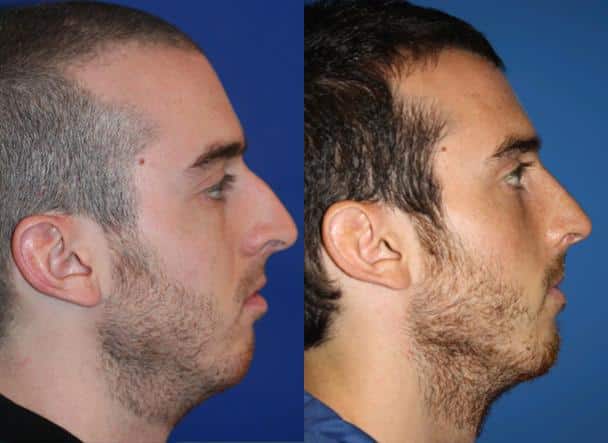
Removing tape should be done with as much care as applying the tape to prevent any harsh movements or pressure. Tweezers can be used to gently peel the tape or remove it after a shower when it is damp and starting to lose adhesiveness, or apply baby oil on the tape and that will loosen it.
How long should I tape my nose after rhinoplasty?
Nose taping is often recommended for 1-3 months after a rhinoplasty procedure. Dr. Miller provides patients with clear instructions for recovery care and taping. Patients will also visit Dr. Miller for follow-up appointments to ensure proper healing and appearance.
Schedule Your Nose Job in NYC
Dr. Philip Miller, MD, FACS, is a world-class, double board-certified plastic surgeon and a leading expert in rhinoplasty procedures and facial rejuvenation. Dr. Miller has more than 20 years of experience in surgical and non-surgical facial procedures and an artistic eye for helping patients meet their cosmetic goals. After a rhinoplasty or revision rhinoplasty procedure, may instruct patients to tape their nose, but it is not always recommended.
Dr. Miller is an innovative expert that offers personalized care and treatment plans. His goal is to empower patients and support aesthetic confidence. Dr. Miller uses the NatraLook® Process to create a positive environment where patients can discuss obstacles and desires for a unified and natural rhinoplasty result.
Contact us to schedule a consultation and learn more about nose taping after rhinoplasty.
What To Do After Rhinoplasty
Finding a skilled and reputable surgeon to perform your rhinoplasty is only half the battle won. Taking the proper precautions to heal is equally important to ensure an optimal outcome.
Philip J. Miller, MD, FACS, is a double board-certified facial plastic surgeon in Manhattan, New York and New Orleans, Louisiana. He is considered a highly skilled facial plastic surgeon with expertise in rhinoplasty. Through decades of working with his patients, Dr. Miller knows that educating his patients is a critical step in ensuring the best possible results for them.
Dr. Miller offers a proprietary consultation process called NatraLook which expands the typical plastic surgery experience into a safe, collaborative environment where you can explore your aesthetic confidence. This opportunity allows you and Dr. Miller to create a unified vision for your results and the safest, most natural outcome possible.
Rhinoplasty is an extensive surgical procedure that requires downtime afterward to ensure the nose heals properly. Preparation for the procedure and subsequent recovery will help ensure a smoother healing process. We have a list of some of the most common questions Dr. Miller gets asked about recovery from rhinoplasty to help you begin your preparation for your own procedure.
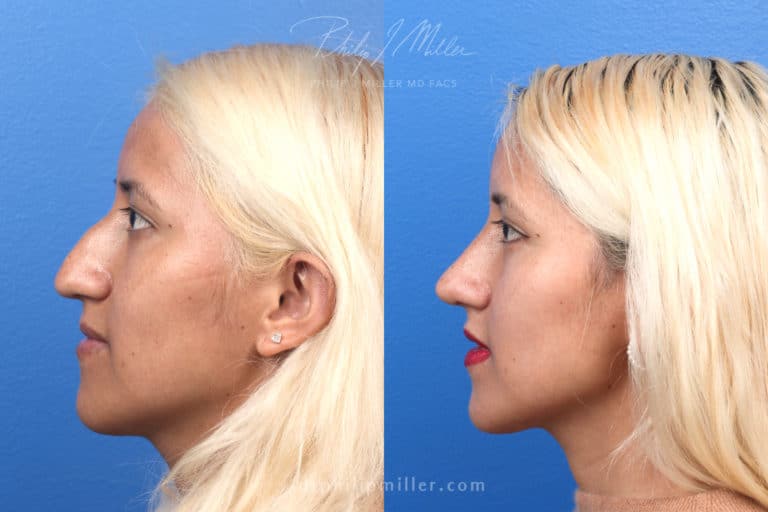
How to clean my nose after rhinoplasty?
Recovery is more than just taking it easy for a few weeks and just resting at home. You will also need to take care of your nose while it heals by keeping it clean and clear. This will not only aid in proper healing, but will help you feel more comfortable too.
Cleaning should only be done after any packing has been removed from your nose. You may use a Q-tip and hydrogen peroxide to gently clean and disinfect your nose. To remove dried blood and mucus out of the nasal passages, you may use a saline spray to irrigate your nose, clear drainage, and keep it moist. The saline may also help reduce swelling in the area.
When can I wash my face after rhinoplasty?
Washing the face is another step that will help you feel better as you go through your rhinoplasty recovery. Once the tape, splint, or cast is removed, you can wash your face with water and a gentle facial cleanser. Avoid rubbing your face around the nose – instead, pat dry carefully so you don’t disturb the treatment area.
What can I eat after rhinoplasty?
Rhinoplasty surgery shouldn’t restrict your diet significantly, but there are general guidelines after your procedure:
- Eat soft, easy-to-digest foods like oatmeal, mashed potatoes, yogurt, scrambled eggs, and soup (not too hot) for the first few days.
- Avoid hard or crunchy food items like apples and carrots that can increase facial movement, or foods like burgers and large sandwiches that require you to open your mouth wide. The idea is to put as little strain on the nasal structure and surrounding tissue as possible.
- Avoid salty foods which will increase fluid retention in your body and can lead to more swelling.
- Eat healthy foods like fruits, vegetables, and proteins that will promote wound healing (e.g., berries, leafy greens, beans, nuts and seeds, and poultry).
- Drink plenty of fluids to keep yourself sufficiently hydrated.
How to massage nose after rhinoplasty
Dr. Miller may prescribe gentle nasal massage on the bridge, middle, or tip of the nose to help soften scar tissue, reduce swelling, and promote healing. Always check with your surgeon before performing any physical therapy or massage after your surgery. In general, the pressure of the massage should be firm enough to smooth the swelling caused by fluids but not so hard that it causes pain, bruising, or deformity to your delicate tissues.
As a general rule, avoid placing any pressure on one part of the nose that causes significant movement in other areas of the nose. You must use your fingers to support the nose to prevent excessive movement during the massage. We will instruct you on how to massage your nose if this is a step we recommend for you during recovery.
How should I sleep after rhinoplasty?
Your nose will be delicate and malleable after surgery, so it is crucial that you do not sleep on your stomach or side for several weeks. These positions can put unnecessary pressure on your nose, cause discomfort, and also compromise your results. Sleeping on your back, elevated with a few pillows, is the best sleeping position for your first week or two of recovery. This position will minimize fluid buildup and congestion. It is also best to sleep alone to avoid any accidental elbow to the face that may impact your rhinoplasty results.
Experiencing slight disturbances in your sleep patterns is normal. Dr. Miller may prescribe a light sleeping aid or pain medication to help you through the first few nights.
Why Dr. Miller is a Top Choice for Rhinoplasty in New York
The best way to ensure a positive recovery after a nose job is to follow all of Dr. Miller’s instructions, go into your procedure with realistic expectations and come to all your follow-up appointments.
To schedule a consultation with Dr. Miller, contact our New York City plastic surgery clinic today.
